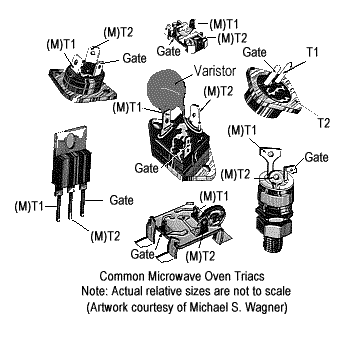Testing a Triac
by Tony van Roon
These two testing procedures are for use with a digital multimeter in the Ohm's
test-range. Testing procedure was actually designed for testing inside micro-waves (magnetrons), but should be no difference
in any other circuit. Test in- or out circuit.
A Triac is an electronic switch or relay. Triacs come in many shapes, sizes, and colors. Check the standard terminal
designations in the picture below which shows most of the types of triacs that are commonly used in microwave ovens,
along with their standard terminal designations.
Located either externally or fixed within an appliance or equipment, the triac operates when it receives an electronics
"gate" signal from the control circuitry. It then switches to its closed or "on" state, thus providing for example, a
voltage path to the primary winding of the H.V. transformer in a microwave oven and so activating the cooking controls.
Or used in a laboratory water-bath which needs to be kept on a specific temperature. The probe-sensor, which is
immersed in the water, keeps track of the temperature and sends a gate signal to the triac to either switch on the
heating or cooling elements. Most of these probe sensors only contain one or more diodes of the general 1N4148 or 1N914 types.
Important Safety Information
 Working on a microwave oven is a VERY dangerous task. Therefore,
BEFORE performing any tests, troubleshooting, or repairs, for your personal safety, I strongly urge you to carefully
read, fully understand and be prepared to follow the very important safety precautions.
Working on a microwave oven is a VERY dangerous task. Therefore,
BEFORE performing any tests, troubleshooting, or repairs, for your personal safety, I strongly urge you to carefully
read, fully understand and be prepared to follow the very important safety precautions.
If you are uneasy or unsure about any of these safety procedures or
warnings; or if you feel uncertain as to their importance or your ability to manage them, it would be in your best
interest to leave the repair to a qualified professional.
 FIRST and ALWAYS, before attempting any repairs,
make certain that the unit is not plugged in. Before touching any components or wiring, ALWAYS DISCHARGE THE
HIGH VOLTAGE CAPACITOR! The high voltage capacitor will quite normally maintain a painfully high-voltage charge
even after the oven is unplugged. Some capacitors employ a bleeder resistor (either externally or internally) that
allows the charge to slowly bleed (or drain) off after the oven is unplugged. Do not trust a bleeder resistor--it may
be open.
FIRST and ALWAYS, before attempting any repairs,
make certain that the unit is not plugged in. Before touching any components or wiring, ALWAYS DISCHARGE THE
HIGH VOLTAGE CAPACITOR! The high voltage capacitor will quite normally maintain a painfully high-voltage charge
even after the oven is unplugged. Some capacitors employ a bleeder resistor (either externally or internally) that
allows the charge to slowly bleed (or drain) off after the oven is unplugged. Do not trust a bleeder resistor--it may
be open.
If you forget to discharge the capacitor, your fingers may ultimately provide the discharge path. You only make this
mistake a few times, because, while the electric shock is painful, the real punishment comes when you reflexively yank
your hand out leaving behind layers of skin on razor-like edges that are there as a reminder to never again forget to
discharge the high voltage capacitor.
How To Discharge The High Voltage Capacitor: The capacitor is discharged by creating a short circuit (direct connection)
the two capacitor terminals and from each terminaL to chassis ground bare metal surface. Do this by touching the blade
of an insulated-handled screw driver to one terminal, then slide it toward the other terminal until it makes contact
and hold it there for a few seconds. (This can result in a rather startling "pop!") Repeat the procedure to create a
short between each capacitor terminal and chassis ground. If the capacitor has three terminals, use the same procedure
to create a short circuit between each terminal and then from each terminal to ground.
Older Amana-made models (generally those manufactured before 1977) have red, round filter capacitors mounted in the
base of the magnetron tube which can also hold a charge. Ground each magnetron terminal by creating a short circuit
to chassis ground using the blade of a screwdriver as explained above.
Triacs with three terminals, such as most shown below, can be tested by making a series of resistance checks as
outlined below.
 In-Circuit: Discharge any capacitors, or
high-voltage capacitors by shorting them out with a piece of wire or insulated screwdriver. BEFORE you do that
however, make sure it is UNPLUGGED! Just in case it is a HV
capacitor, be warned that it may give quite a crack! Repeat the procedure a couple times to make sure they are completely
discharged.
In-Circuit: Discharge any capacitors, or
high-voltage capacitors by shorting them out with a piece of wire or insulated screwdriver. BEFORE you do that
however, make sure it is UNPLUGGED! Just in case it is a HV
capacitor, be warned that it may give quite a crack! Repeat the procedure a couple times to make sure they are completely
discharged.
Here is the complete testing procedure for TEST-1:
1) Unplug the appliance, equipment, or whatever you're working on.
2) DISCHARGE THE HIGH VOLTAGE CAPACITOR
3) First identify the terminals. The three terminals are generally designated as G (gate), T1 and T2 (a rule of thumb: smallest
terminal is the gate; medium sized is T1; largest is T2).
4) Carefully remove all harness leads. A soldered-in varactor or snubber may remain attached providing it is in good
condition.
5) Set and zero the ohmeter to a scale capable or reading about 40 Ohms.
6) Measure from the gate to T1, note the reading, then reverse the leads.
7) In each measurement, a normal reading would be in the range of 10 to 200 ohms, depending on the Triac model.
8) Next, set the meter to its highest resisitance scale. Each of the following reading should produce a normal reading
of infininty:
a. From T1 to T2.
b. From T1 to the gate.
c. From each terminal to chassis ground.
These reading are approximate and may vary with manufacturer, but generally speaking, any results that are significantly
different would point to a defective Triac.
 Test 2
Test 2
A second way to test the Triac is to evaluate its gate-firing capability:
1) Unplug the oven.
2) DISCHARGE THE HIGH VOLTAGE CAPACITOR.
3) Remove all the harness leads. Set the meter to a scale capable or reading about 50 Ohms.
4) Attach the negative meter lead to T1 and the positive lead to T2.
5) Now, using a screwdriver blade, create a momentary short between T2 and the gate. This
brief contact should turn the triac "on", thus producing a meter reading of about 15 to 50 Ohms.
6) Next, disconnect one of the meter leads, then re-connect it. The meter should return a reading of infinity.
7) And finally, reverse the meter leads and repeat the tests. The results should be the same.
8) After many experiments with different multimeters and Triacs, I must conclude that this method is not always succesfull.
Any abnormal tests would suggest a defective Triac.
Replacement Triacs are generally available from your local appliance parts distributor(like Sears) or electronics store.
If you like, build this simple SCR tester. It will also test
TRIACS with good results. A simple "good/bad".
The graphics and most of the text courtesy of Microtech Electronics. If you have any question(s), please ask the
author of this testing sequence: J. Carlton Gallawa
or visit his website at "Microtech Electronics" to learn more about
high voltage, microwaves or how to become a seisoned microwave technician!
Back to Circuits or Gadgets page.
 Working on a microwave oven is a VERY dangerous task. Therefore,
BEFORE performing any tests, troubleshooting, or repairs, for your personal safety, I strongly urge you to carefully
read, fully understand and be prepared to follow the very important safety precautions.
Working on a microwave oven is a VERY dangerous task. Therefore,
BEFORE performing any tests, troubleshooting, or repairs, for your personal safety, I strongly urge you to carefully
read, fully understand and be prepared to follow the very important safety precautions. FIRST and ALWAYS, before attempting any repairs,
make certain that the unit is not plugged in. Before touching any components or wiring, ALWAYS DISCHARGE THE
HIGH VOLTAGE CAPACITOR! The high voltage capacitor will quite normally maintain a painfully high-voltage charge
even after the oven is unplugged. Some capacitors employ a bleeder resistor (either externally or internally) that
allows the charge to slowly bleed (or drain) off after the oven is unplugged. Do not trust a bleeder resistor--it may
be open.
FIRST and ALWAYS, before attempting any repairs,
make certain that the unit is not plugged in. Before touching any components or wiring, ALWAYS DISCHARGE THE
HIGH VOLTAGE CAPACITOR! The high voltage capacitor will quite normally maintain a painfully high-voltage charge
even after the oven is unplugged. Some capacitors employ a bleeder resistor (either externally or internally) that
allows the charge to slowly bleed (or drain) off after the oven is unplugged. Do not trust a bleeder resistor--it may
be open. In-Circuit: Discharge any capacitors, or
high-voltage capacitors by shorting them out with a piece of wire or insulated screwdriver. BEFORE you do that
however, make sure it is UNPLUGGED! Just in case it is a HV
capacitor, be warned that it may give quite a crack! Repeat the procedure a couple times to make sure they are completely
discharged.
In-Circuit: Discharge any capacitors, or
high-voltage capacitors by shorting them out with a piece of wire or insulated screwdriver. BEFORE you do that
however, make sure it is UNPLUGGED! Just in case it is a HV
capacitor, be warned that it may give quite a crack! Repeat the procedure a couple times to make sure they are completely
discharged. Test 2
Test 2